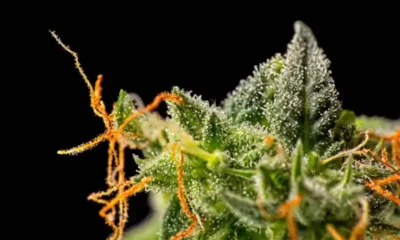Connect with us
Published
1 year agoon
By
Tyler Shultz
A new study from the University of California, Irvine found exposure to THC at a young age could lead to a reduction of ovarian follicles and matured eggs by almost 50 percent in adulthood.
Researchers at the UCI School of Medicine, under the UCI Center for the Study of Cannabis, used a mouse model to examine the effects of THC and began by injecting young mice with THC for two weeks, studying how they were affected post-injection. The results showed a decrease in healthy ovarian follicles by nearly 50 percent in primordial follicles, which are the fundamental reproductive units of the ovary and are non-renewable. The researchers believe the decrease in ovarian follicles is due to a hastened activation of dormant follicles, followed by follicle death later in their development due to DNA damage.
“Given that more and more teenagers and young adults are using cannabis, especially with easier access to the substance, this study’s findings are especially important,” said senior and corresponding author Dr. Ulrike Luderer, professor of environmental and occupational health at the UCI Program in Public Health. “It is imperative to widely broadcast the consequences of early-life exposure to cannabis on reproductive health in adulthood.”
The researchers suggest the outcomes are due to the endocannabinoid system, a signaling process that regulates a number of bodily functions in mammals. The study also found ovarian follicles contain proteins that are part of the ECS, specifically cannabinoid receptors type 1 and type 2, which are triggered by THC and its active byproducts.
“Our findings provide unexpected new insights into the long-term impact of THC on reproductive function and aging,” said co-author Daniele Piomelli, Ph.D., distinguished professor of anatomy and neurobiology at the UCI School of Medicine and director of the UCI Center for the Study of Cannabis. “Our hope is that our findings will motivate teenage girls to make better, more informed decisions about whether or not to ingest cannabis products.”
The study was conducted as cannabis use rates among adolescents and young adults continue to soar, with a recent study conducted by the Oregon Health & Science University finding cannabis use among adolescents has increased by about 245 percent since 2000. The findings from the OSHU study found over 330,000 instances of intentional abuse or misuse among children aged 6-18.
“Our study describes an upward trend in marijuana abuse exposures among youth, especially those involving edible products,” said lead author Adrienne Hughes, M.D, assistant professor of emergency medicine in the OHSU School of Medicine. “This information is important because it will allow researchers to better understand the trends and make recommendations to improve clinical care and interventions aimed at reducing substance misuse among youth.
The university was previously awarded a four-year, $9 million grant from the National Institute on Drug Abuse to study the effects of cannabis use on adolescents. Indiania University has also received funding form the National Institutes of Health’s National Institute on Drug Abuse, with the university announcing neuroscientists at the IU Gill Center for Biomolecular Science received a $2 million grant to study the effects of cannabis on adolescents aged 12-14. Researchers at IU have also developed a method using mice with varying genetic backgrounds to study the effects of cannabis on adolescence, and are even using both male and female mice to see if there are any sex-dependent differences from THC use.
The latest study supported by the National Institute on Drug Abuse Center under grant P50DA044118; the National Institute for Health under grant R01ES020454; and the Impact of Cannabinoids across the Lifespan Pilot Grant. The study was published online in the journal Toxicological Sciences.


Despite City Efforts, Hemp Shops Posing as Dispensaries Prevail in Las Vegas


Cannabis Community, Investors React to DEA Decision To Reschedule


Georgia Governor Signs Bill Establishing Licensing Requirements To Grow Hemp


Study: Psilocybin Enhances Meditation


Ohio GOP Lawmakers Debate Adult-Use MJ Priorities, Eye June for Regulation Approval


Taylor Swift Puts Narcotics Into All of Her Songs on ‘The Tortured Poets Department’
